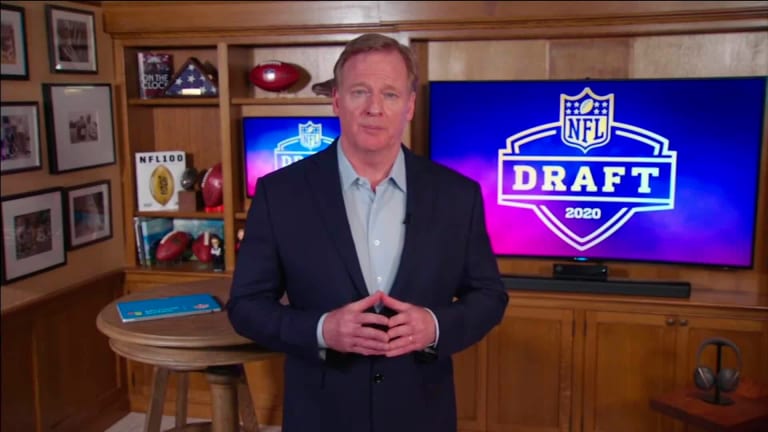
NFL "Throw Back" Draft Dials It Down To Mishaps And Missteps of Yore

People have asked me to name the greatest technological advancement I've seen in my lifetime.
Short of the Moon landing and the Internet, I often say "The NFL Draft."
I hardly recognize the horse-and-buggy event I first covered as an NFL beat writer in the early 1980s.
Life was simpler then and, for us, better. Remember, ESPN was just getting off the ground and there was no free agency. The players were indentured, definitely not good for them. And there were very few trades.
The NFL was the most 9-to-5 job you could get in sports writing and I liked it just fine.
While covering the Rams coached by John Robinson, it worked like this: About a week before the April draft, Robinson would host the beat writers for dinner at a nice restaurant in Newport Beach. We'd talk about the off season (we had one then), and good movies we'd seen. Then Robinson would go over the draft and give us some insight on who the Rams might take.
And that was it.
By the time I left the NFL in 1991 the draft was on its way to becoming the Ziegfeld Follies on steroids. And by steroids I'm thinking the Brian Bosworth circus hype that would only be stopped by the front-side of Bo Jackson.
The NFL draft of my day has gone from GMs with rolled up papers and cigar smoke to non-stop, around-the-clock hype, camera and action.
It got so bad in recent years I could only watch the draft, with the sound down, wearing sunglasses. Of course, it goes without saying, the event that conjugated what happened to the draft was the holy matrimony of Mel Kiper Jr.'s draft book to ESPN upper management.
The NFL's logical and careening course was headed straight to glitz-city Las Vegas on Thursday night before an awful pandemic took it down like Dick Butkus.
The ONLY good thing to come out of this tragedy was a massive scale back of this year's draft. Some people of my age were willing to return to an age of reason, simplicity and one talking head talking at a time.
When I heard NFL Commissioner Roger Goodell was going to oversee this year's draft from his home basement, well, that got my attention.
Maybe this was a draft I could watch.
It rekindles memories of an early 1980s draft when, before ESPN's cables were fully connected, I stood outside of the Rams Park cafeteria and watched a bee fly into the headset of an ESPN reporter doing a live report from a spot on the asphalt that used to be a tether-ball court at an elementary school.
It may have been the last time I felt fully comfortable in the future of newspapers.
There is one thing that glitz, glamour and technical resources hasn't changed about the NFL draft: its laughability factor.
Year after year the best and brightest misjudge, like drunken sailors on leave, and misappropriate funds on guessing how good an incoming college football player might be.
Think about it: Joe Montana was a third-round draft choice and Tom Brady went in the sixth, 199 overall.
Bart Starr, out of Alabama, went in the 17th round to Green Bay. When Starr arrived the team issued him uniform No. 42. Starr, in case you're from Mars, played the quarterback position.
"It was obvious they thought I was not going to stay," Starr told me years ago for a pre-draft story.
Deacon Jones (1961, South Carolina State, 14th round to L.A. Rams).
You talk about a head (I mean face) slap. Dwight Clark was a 10th-rounder to San Francisco.
Part of my aversion to drafts may have been the blundering I witnessed while covering so many shout shows.
In 1986, my first full season on the beat, the Rams used their No. 23 pick in the first round on offensive tackle Mike Schad out of Queens, Canada. As if a starting quarterback out of Canada, Dieter Brock, wasn't enough.
The fact you don't know who Schad is tells you how the pick worked out.
Next year, 1987, the Rams didn't have a first-rounder so I remember mostly eating a lot of popcorn.
In 1988, though, the Rams were supposed to build a Super Bowl run with two first-round picks, and three-seconds, acquired in the 1987 Halloween trade of Eric Dickerson.
The Rams got the same number of picks in 1988 and here's what they did with the four firsts: Gaston Green, Aaron Cox, Bill Hawkins, Cleveland Gary.
The best and worst of the two UCLA second-rounders were Flipper Anderson and Darryl Henley, who is currently serving a life sentence on a murder-for-hire attempt.
I also covered the 1991 Raiders' draft where, against my advice, Al Davis selected quarterback Todd Marinovich with the No. 24 overall pick.
"We see a little bit of Kenny Stabler in him," Coach Art Shell said at the time.
It was more Kenny Loggins.